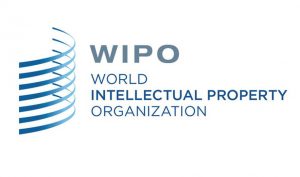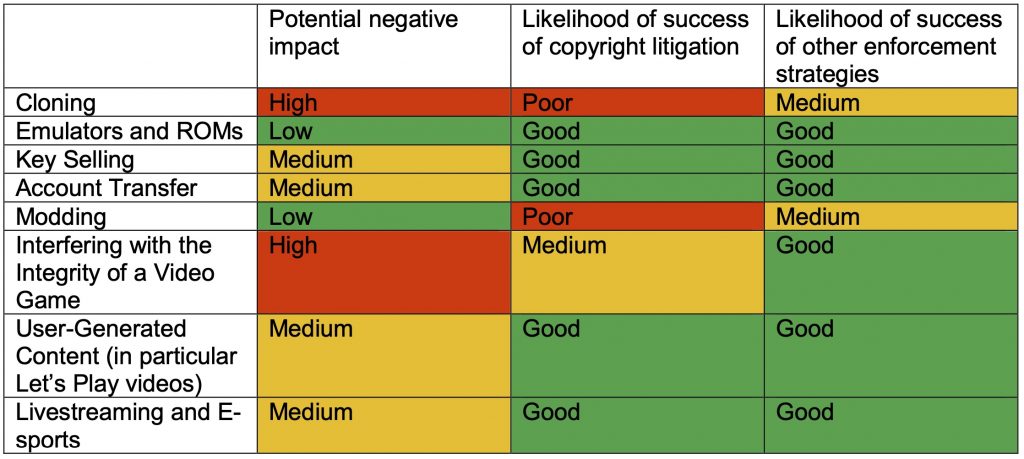 Research commissioned by the World Intellectual Property Organization identifies potential game-specific infringing use-cases, and groups them according to stages within a game’s product life-cycle.
Research commissioned by the World Intellectual Property Organization identifies potential game-specific infringing use-cases, and groups them according to stages within a game’s product life-cycle.
Risks during the creation of a video game include the incorporation of third-party intellectual property into a game and cloning of a game. In distribution, games can be played in emulators different than those the game was developed for, distribution rights can be infringed, and access keys can be sold illegally.
A game also can be altered by modifying elements of the game itself in ways not intended by the developer, and content generated in the game and protected could be monetized. Other exploits include cheating (distributing cheat codes), infringing private distribution, and repurposing of elements of a game outside the context of the game.
The study takes into consideration the nature of the infringement and its potential detrimental effect on game businesses, the nature of entities taking action, the identity of the potential infringer, and the jurisdiction in which the infringement takes place.
The study finds that:
- Video games are complex digital creations potentially comprised of multiple works of authorship, and whilst they can undoubtedly be protected by copyright to some extent, there is no international consensus on the nature of this protection.
- While there are several international and regional initiatives to standardize and harmonize copyright law, many aspects of the legal regime are considered to be subject to national jurisdictions on the account of copyright (and intellectual property rights in general) are territorial in nature.
- End user license agreements (EULAs) are essential in granting permission to access and use the copyright protected work, under specific conditions (proprietary, open-source license, end-user license agreement).
- Technical protection measures (TPMs) complement EULAs by limiting access or controlling copying of protected works. The use of TPMs is then reinforced by complex and extensive laws prohibiting circumvention of such measures, by way of overlapping civil and criminal actions.
Risks and remediation
In a lengthy analysis, the study identifies relevant infringing uses and practices and examines the range of enforcement strategies available to video game companies. The figure below summarizes the analysis.

Fighting piracy
Enforcement strategies against piracy include litigation against the operators of piracy sites; applying for website blocking injunctions requiring ISPs to block their subscribers’ access to these sites; utilizing the notice and takedown mechanisms implemented by many hosting providers; and applying TPMs.
Considering that many aspects of copyright law are not harmonized and remain subject to national legislation, and enforcement is territorial, the study reports on jurisdictions where specific legislative responses and case law are available.
The study was developed and written by researchers from Queen Mary University of London and the University of Bristol in the UK.
Download the study: Copyright Infringement in the Video Game Industry, WIPO, September 2022
Why it matters
IPR issues surrounding game piracy are complex. “Given the global and highly complex nature of the industry, the gaps in harmonization of copyright law, and the interactivity inherent to video games, we are faced with diverse and often unique uses, practices, and strategies that are not easily translated into specific industry-wide policies and strategies,” said Dr. Michaela MacDonald, of the School of Electronic Engineering and Computer Science Lecturer at Queen Mary University of London.
Dr Yin Harn Lee, Senior Lecturer in Law at the University of Bristol, said: “Our analysis shows that not all unauthorized uses and practices pose a commercial threat to the video game industry. In fact, practices such as streaming, modding and the creation of user-generated content are often beneficial to the industry and indicates the existence of a thriving user community. In the interests of maintaining a positive relationship with the most engaged segments of their user communities, video game companies should adopt a multi-layered strategy to copyright enforcement.”
Countermeasures against the unauthorized online distribution and downloading of copies of video games are generally the same as those applicable to piracy of other types of copyright-protected works.
Together with contracts and license agreements, IPRs form the foundations of the video game ecosystem, facilitating interactions among all relevant stakeholders – developers and publishers (video game companies), distributors, retailers, platform owners and players – on a global scale
[ Note: This article quotes directly from the study ]












